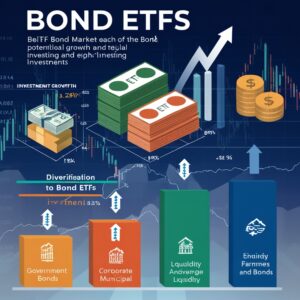Understanding ETFs: A Comprehensive Guide to Bond ETFs and Investment Strategies
What is an ETF?
The term “ETF” means “exchange-traded fund“. An ETF is a type of investment fund that is traded on a stock exchange, like individual stocks. These funds hold a collection of assets—such as stocks, commodities, or bonds—and are designed to track the performance of a specific index, sector, or asset class. ETFs offer investors the benefits of diversification, liquidity and transparency,
Bond ETFs: An Overview
Bond ETFs typically focus on fixed-income securities, providing exposure to a wide variety of bonds, including government bonds, corporate bonds, municipal bonds, and international bonds. These funds enable investors to gain diversified exposure to the bond market without directly purchasing individual bonds.
Types of Bonds: An Overview
Bonds are fixed-income securities that represent a loan made by an investor to a borrower. They are categorized based on various factors, including the issuer, the risk profile, and the tax treatment. Here’s an overview of the primary types of bonds:
1. Government Bonds
Treasury Bonds: Issued by the federal government, these bonds are considered very low-risk. They include Treasury bills (short-term), Treasury notes (medium-term), and Treasury bonds (long-term).
Municipal Bonds: Issued by states, cities, or other local government entities, municipal bonds are often tax-exempt, making them attractive to investors in higher tax brackets.
2. Corporate Bonds
Issued by companies to raise capital, corporate bonds can vary widely in terms of risk and return. They are rated by credit agencies, with investment-grade bonds considered safer than high-yield (or junk) bonds, which offer higher returns at greater risk.
3. Agency Bonds
Issued by government-affiliated organizations (such as Fannie Mae and Freddie Mac), agency bonds generally carry a slightly higher risk than Treasury bonds but are still considered relatively safe.
4. Foreign Bonds
Bonds issued by foreign governments or corporations. These can expose investors to currency risk, but they may also provide opportunities for higher returns.
5. Zero-Coupon Bonds
These bonds do not pay periodic interest. Instead, they are sold at a discount to their face value and mature at par, providing a lump-sum payment at maturity. The difference between the purchase price and the face value represents the investor’s earnings.
6. Convertible Bonds
Corporate bonds that can be converted into a predetermined number of the company’s equity shares. They offer the potential for capital appreciation alongside regular interest payments.
7. High-Yield Bonds
Also known as junk bonds, these are bonds rated below investment grade. They offer higher yields to compensate for the increased risk of default.
8. Inflation-Protected Bonds
These include Treasury Inflation-Protected Securities (TIPS) in the U.S., which adjust their principal value based on inflation, providing investors with protection against rising prices.
9. Subordinated Bonds
These bonds have a lower claim on assets in the event of a liquidation compared to senior bonds. They typically offer higher yields to compensate for the increased risk.

